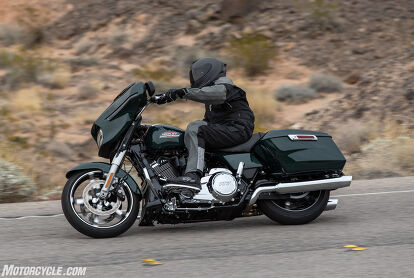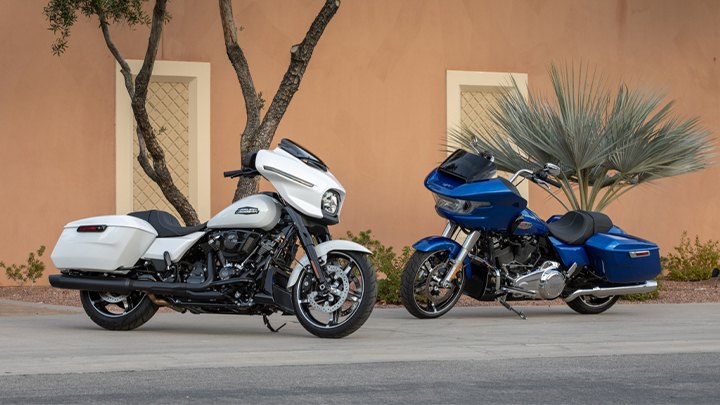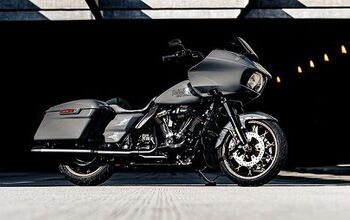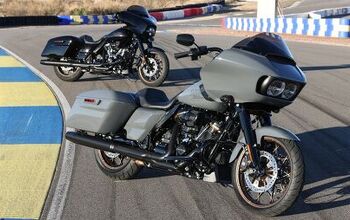2024 Harley-Davidson Road Glide and Street Glide Review – First Ride

New and improved and yet still the same. Everything’s going to plan.
Brad Richards has a tough task. What do you do when you’re tasked with designing a ground-up revamp of your company’s most successful and coveted models? Two motorcycles that have etched themselves into the history books largely because of the way they look? The answer, as it always has been, boils down to three words: Refinement. Refinement. Refinement.
2024 Harley-Davidson Road Glide and Street Glide
New, yet very familiar, the two Glides are highlighted by a bigger engine, revised suspension, and big electronic updates. Through it all, there's no mistaking what bikes you're riding.
Editor Score: 82.5%
Engine | 17.5/20 | Suspension | 11/15 | Transmission | 7.5/10 |
Brakes | 7.5/10 | Instruments | 5/5 | Ergonomics | 8/10 |
Appearance | 9/10 | Desirability | 8.5/10 | Value | 8.5/10 |
Highs
- Fantastic 12.3-inch TFT display
- Updated Milwaukee-Eight 117 doesn't lack for torque
- Who doesn't like a little bit of weight savings?
Sighs
- Three inches of rear suspension travel? C'mon.
- Stiff clutch pull
- Standard Road Glide bars might be uncomfortable for short arms
When you look at the 2024 Harley-Davidson Road Glide and Street Glide, unless you’re an ardent Harley historian, you know instantly what you’re looking at. But if I hadn’t mentioned anything about the model year, you’d be hard pressed to distinguish whether this was a new bike or one that was 10 years old. Chamfers along the fairing carry the eye past the trademark teardrop 6-gallon fuel tank, before moving on to the saddlebags and terminating at their trailing edge. It’s a subtle change, but subtle is good when dealing with one of the most iconic silhouettes in motorcycling.
In this case, design freedom comes when you look at both Glides head-on – but especially the Road Glide. One of the most impactful design changes for the Glide family has been the new LED headlight designs. With the Road Glide, you have a huge horizontal headlamp staring right back at you. Richards says the design was inspired by a human face wearing goggles or a facemask. I guess the pandemic had a greater impact on motorcycle design than any of us realized.
It’s a clean design that now integrates daytime running lights and turn indicators, so there’s nothing else cluttering up the frame-mounted fairing, ensuring it remains one of the focal points of the Road Glide’s presence.
The Street Glide also sees a cleaned-up, distinguished look, as the central headlight is also an LED, but is now flanked on both sides by the “eagle wings” that act as both daytime running lights and turn indicators. Again, all the clutter from separate turn signals is gone, and when you see this face at night, it’s easy to distinguish what bike it is. For a complete rundown of the changes to the 2024 Road Glide and Street Glide, be sure to check out our First Look article by clicking the link below.
Personally, I find myself gravitating towards the Road Glide as I really like the broad-shoulders of the frame-mounted fairing, and that headlight really captures my attention, even if I can’t see it from the saddle. No matter what anyone says, your motorcycle choice is a reflection of you, and riding a bagger does bring with it a certain attitude or persona, and I’ll admit it – hopping on the Road Glide makes me feel cool. It may not be for me everyday, but I get the appeal of feeling that loping 45º V-Twin rumble underneath you while the miles burn away. And how can you not like the distinctive sound accompanied by the forward thrust once you twist the grip?
For the first time in Harley history, the MY24 Glides come with a full electronic suite of rider safety aids – the kinds normally seen on sportbikes of just a few years ago. These include Cornering Electronically Linked Brakes, Cornering ABS, Cornering Traction Control (with different modes), Cornering Drag Torque Slip Control, Vehicle Hold Control, and Tire Pressure Monitoring. True, none of these things is as sexy as horsepower and torque, but if you ever find yourself needing them – sometimes after the fact – you’ll be glad they’re there.
Same Name, More Power
For 2024, that thrust is ramped up a little more thanks to the new-and-improved Milwaukee-Eight 117. Despite the name, this is not the same as the 2023 M8 117s, as the new bike makes 3% more power (105 hp) and 4% more torque (130 lb-ft). Shoving more air into the engine is the basis for this power bump, and credit here goes to the new airbox and air filter for the 117. With a capacity of 4.0 liters, the new airbox is more than 50% bigger than the 107/114 engines with the Heavy Breather intakes. Molded within the airbox is a new intake design that’s smoother, with less harsh bends for the air to travel around. The throttle body itself is bigger, at 58mm compared to 55mm on the 2023 M8 117 engines.
Handling the larger income of air are redesigned cylinder heads with oval intake ports and low-profile intake valve seats for more intake air velocity and tumble. Combined with the deeper spark plugs and a different squish band, the air-fuel ratio now gets squeezed even tighter as compression ratio has gone up a point to 10.3:1 (from 10.2:1). The sum change creates more turbulence for a more powerful explosion once the spark plug ignites.
From where I was sitting, the 130 lb-ft. was enough to satisfy my need for thrust, though the pull on the cable-actuated clutch seemed especially stiff on numerous bikes I tried. Nonetheless, each twist of the throttle made either Glide giddyup with authority. With such little time with the bikes, as we’ll get to below, I kept the bike in Sport mode (Road, Rain, and Custom were the other options). You get a noticeable pop in power in Sport mode that should give you the edge in most stoplight-to-stoplight drag races. Metering of the power is smooth and linear, to the point I didn’t see a reason to try the other modes.
Of course, more power creates more heat, and this is where the new cooling system comes in. The new-and-improved liquid-cooled heads (NOT a liquid-cooled engine, as Harley stressed to us) focuses the coolant flow to the rear cylinder head first, as it gets less air flow and is thus hotter. Coolant then moves to the front cylinder before heading back to the radiator. Cleverly, the cooling fan on the radiator directs air flow underneath the bike so it’s not hitting the rider or passenger.
On The Road
It’s at this point I have to confess a major caveat to this review: I was only able to ride the Road and Street Glides for about 20 miles, as our original tour through the Valley of Fire was cut short due to rain. Not wanting to potentially get trapped in a flood plain, Harley brass put the kibosh on our ride once drops started to fall from the sky.
Nonetheless, 20 miles was enough to leave a first impression. And that first impression has me conflicted. As much as I dig the road presence of the Road Glide, I found myself far more comfortable with the ergonomics of the Street Glide. The RG’s bars were higher, wider, and farther away compared to the SG’s. It made a big difference in terms of comfort for my stubby arms. Taller, more lanky riders will likely gravitate to it more. Thankfully, the Road Glide’s bars can be rotated. If it were my bike, I’d turn them closer to me before I even left the dealership.
The Street Glide’s bars, by comparison, fell naturally where I’d stick out my hands. The bars are a little narrower and they are definitely closer to the rider. Both seats are reshaped to move the rider’s hips into a more neutral position, but overall my 5-foot, 8-inch frame and 30-inch inseam felt more at home on the Street Glide.
With such limited time on the bikes, it’s hard to get any real impressions on their handling other than to note how surprisingly nimble both Glides are at low speed – which reminds me why a lot of police forces use them. Harley engineers were able to lob 18 lbs off the Street Glide compared to last year and 16 lbs off the Road Glide thanks to lighter weight materials used all around. I know that sounds like nothing on bikes tipping the scales at 800 lbs, but that’s better than saying they both put on 20 lbs, right? Less weight, no matter how little, is a welcome addition. Or should that be subtraction? Anything that can be done to make it easier to lift the Glides off their sides is something we’ll take.
Despite our limited time, one difference between the standard Glides and the CVO Road Glide ST is the traditional fork on the standard bikes instead of the inverted piece on the CVO. Having ridden the CVO the day before, the amount of flex from the front on the standard Glides presented itself as a slightly less planted front end. The feedback in the bars was just slightly more vague and you could feel tiny movements as the forces from the road and suspension were working their way from the triple clamp and ultimately to the rider’s hands. Of course these sensations would be hard to notice without riding both bikes back-to-back.
While a diet plan is nice, our rant with the Glides’ lack of rear suspension travel remains. Even though there’s 50% more travel this year compared to last (for a total of 3 inches), that’s not nearly enough. Bumpy roads, of which America has a lot of, will use up the available travel quickly, and without any adjustments available to you the ride will suffer as a consequence.
Then again, in a roundabout way, maybe this is a reminder to slow the pace and enjoy the scenery. The loping V-Twin sounds better when it’s cruising anyway. Nestle inside the bubble created by either the frame-mounted or fork-mounted fairings and it’s a nice place to be thanks to improved aerodynamics. If it’s not, just adjust the air vane on the windscreen to move the air above or around your head the way you like. Buried in Harley’s literature is a hilarious stat that says in wind tunnel testing *subjective* helmet buffeting was reduced by 60% compared to last year. As ambiguous a stat as that is, I found the air vane made a huge difference in the serenity of the cockpit, as I experienced massive helmet buffeting with the vane completely horizontal (on both bikes). Moving the vane so airflow moved over my head made all the difference. So, the new aero works – it just needed to be worded better.
Once settled into the Glide’s cockpit, one can’t help but look at the huge 12.3-inch TFT display. It’s simply clearer, brighter, and more impressive than the 6.5-inch BOOM! GTS screen used before, and has touchscreen capability even with gloves (though buttons on the left grip will get the most out of it). Harley’s made the most of this new screen by enabling three different displays: Cruise, Sport, or Tour. Cruise shows the usual tach and speedo, Sport places the tach in the center, while Tour is the most impressive, as the screen converts to a giant map. If you’ve activated the optional $349.95 navigation, you’ll get turn-by-turn directions right there on the map. Scroll through the gallery below to see the different screen choices.
Quick Take
Twenty miles does not a complete test make, but it was enough to discover some highs and lows. The styling exercise, especially for the Road Glide, is a hit for me. Combine that with the small weight reduction, increased power, and amazing infotainment, and both Glides should easily be able to carry the mantle for The Motor Company’s touring heritage. But it would be nice if the Road Glide were a little more small-person friendly, at least in terms of ergos. Some more rear suspension travel would do the Glides a lot of good, too.
Starting at $25,999, both the Road Glide and Street Glide have outdone themselves compared to past models. Time will tell if it’s enough to beat out the competition – the Indian Chieftan and Challenger.
Troy's Gear

- Helmet: Scorpion EXO-R1 Air Carbon
- Suit: Aerostich R-3 Men’s One Piece
- Airbag: REV’IT! Avertum Tech-Air
- Gloves: Alpinestars Equinox Gore Tex X-trafit (Discontinued)
- Boots: Alpinestars Superfaster Shoes
2024 Harley-Davidson Road Glide/Street Glide Specifications | |
|---|---|
MSRP | $25,999 |
Engine Type | Milwaukee-Eight 117, air/liquid-cooled 45º V-Twin, single cam actuating four valves per cylinder via pushrods and hydraulic valve lash adjustment |
Capacity | 1,923cc (117ci) |
Bore x stroke | 103.5 mm x 114.3 mm (4.075" x 4.50") |
Compression Ratio | 10.3:1 |
Horsepower | 105 hp at 4,600 rpm (claimed) |
Torque | 130 lb-ft at 3,250 rpm (claimed) |
Engine control | Electronic Sequential Port Fuel Injection (ESPFI) |
Clutch | Mechanically actuated 10 plate, wet Assist & Slip |
Transmission | 6-Speed |
Final Drive | Belt, 32/68 ratio |
Primary Drive | Chain, 34/46 ratio |
Headlight | LED low and high beam |
Frame | Mild steel; tubular frame; two-piece stamped and welded backbone; cast and forged junctions; twin downtubes; bolt-on rear frame with forged fender supports; MIG welded. |
Front Suspension | 49mm Dual Bending Valve |
Rear Suspension | 3 in. Dual Outboard Emulsion with Preload Adjustability |
Front Brake | 32 mm (1.3 in.), 4-piston fixed dual axially mounted calipers, 320mm discs |
Rear Brake | single axially mounted, fixed 300mm disc |
ABS | Standard |
Rake / Trail | 29.25° / 6.8 in. (Street Glide: 29.25º/6.7 in.) |
Wheelbase | 64.0 inches |
Front Wheel | 3.50 x 19" Cast Aluminum |
Rear Wheel | 5.0 x 18" Cast Aluminum |
Front Tire | 130/60B19 M/C 61H |
Rear Tire | 180/55B18 M/C 80H |
Length | 94.9 in. |
Width | 37.2 in. (Street Glide: 38.4 in.) |
Seat Height (Laden) | 26.6 in. (Street Glide: 26.1 in.) |
Curb Weight | Road Glide CVO: 838 lb. Street Glide CVO: 811 lb. (claimed) |
Fuel Capacity | 6.0 gal. |
We are committed to finding, researching, and recommending the best products. We earn commissions from purchases you make using the retail links in our product reviews. Learn more about how this works.
Become a Motorcycle.com insider. Get the latest motorcycle news first by subscribing to our newsletter here.

Troy's been riding motorcycles and writing about them since 2006, getting his start at Rider Magazine. From there, he moved to Sport Rider Magazine before finally landing at Motorcycle.com in 2011. A lifelong gearhead who didn't fully immerse himself in motorcycles until his teenage years, Troy's interests have always been in technology, performance, and going fast. Naturally, racing was the perfect avenue to combine all three. Troy has been racing nearly as long as he's been riding and has competed at the AMA national level. He's also won multiple club races throughout the country, culminating in a Utah Sport Bike Association championship in 2011. He has been invited as a guest instructor for the Yamaha Champions Riding School, and when he's not out riding, he's either wrenching on bikes or watching MotoGP.
More by Troy Siahaan






























































































Comments
Join the conversation
I swear no allegiance to any brand or country of orgin and I'm by no means part of the Harley Davidson faithful. I do have a soft spot for the big touring models though - particularly the Street Glide and Ultra Limited. A few years ago I owned an U/L and although I ditched it due to issues I had with it and the dealer (oil consumption - not sumping), I absolutely loved riding it. I was always amazed at how light and maneuverable such a big lump of a bike felt and the torque was addictive. I’d love to have another to compliment my other bikes but lack of room and that nagging thought about reliability dictate a no vote.
I think Harley has done a very good job of updating the styling and the bump in power certainly doesn’t hurt.
Suspension should have more travel and the side cases should carry more IMO
The prices sure raise eyebrows but my GS A wasn’t a bargain either… neither was my Bronco etc, etc.
I’d never say I’ll never own another.
I was at a Harley dealer two days ago and sat on both bikes. For me, the surprise was in how easily I could lift the Street Glide off of its side stand. The Road Glide was a different story. The RG is twenty-seven pounds heavier, and every one of those pounds is up in the fairing. The ape-hangers didn't help.
A lot of money for those bikes but they just might be worth it.